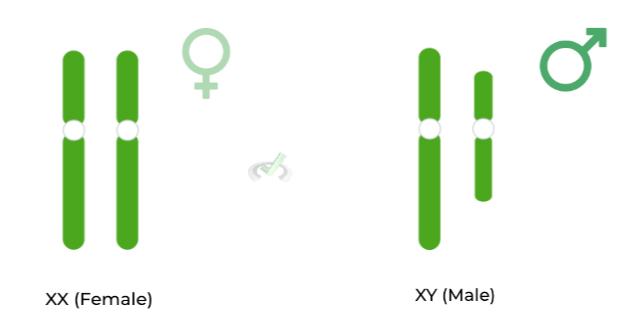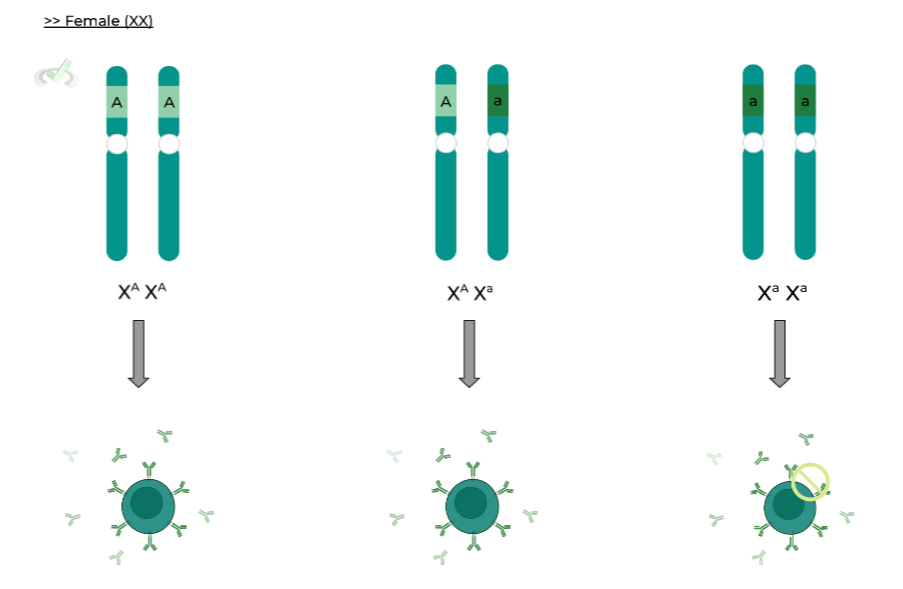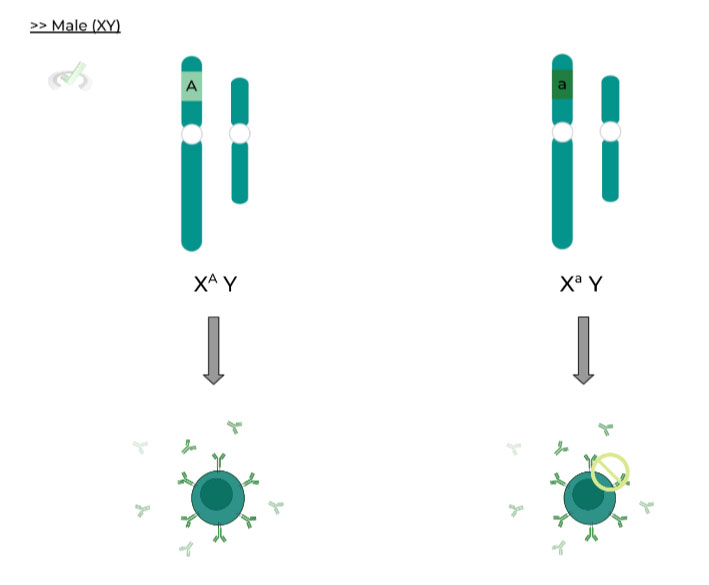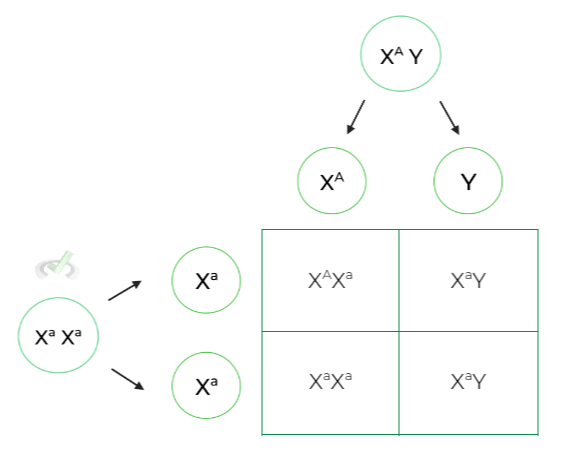I. What are Sex Linked Genes?
In the previous articles covering mendelian genetics, punnett square, and different expression patterns, we;ve only been covering them in the context of autosomal (nonsex) chromosomes. Now, let’s approach these concepts in the context of sex chromosomes!
Luckily, the dominance patterns are essentially the same for sex chromosomes! With the exception of some caveats and considerations, reading this article should hopefully seem fairly familiar and be a callback to previous articles!
In another article, we’ll specifically cover disease and how mendelian genetics plays a role in the inheritance of these diseases. Just as with the autosomal chromosomes, the sex chromosomes also play a role in the inheritance of certain disease as we’ll discuss in another article!
II. Content Review
Let’s take it back to the basics and review the sex chromosomes! As indicated by their name (duhhh….), these chromosomes determine your sex: XX (female) or XY (male).

The XY combination of sex chromosomes is actually the only case where the chromosomes are not homolgous because they do not contain the same genes!
For example, the Y chromosome contains the SRY gene (sex determining region gene) which codes for proteins which promote male sexual differentiation. Notice also how the Y chromosome is much smaller than the X chromosome.
>> Sex-Linked Genes and Traits
While primarily involved in sexual differentiation, sex chromosomes also house other genes critical for function, and as such are termed sex-linked genes.
When talking about sex-linked genes, the MCAT will only test those on the X chromosome, aptly named X-linked genes and traits, so you won’t have to worry about learning inheritance patterns for genes/traits on the Y chromosome.
In addition, while sex-linked genes can follow all patterns of expression, the MCAT will primarily test sex-linked genes with a complete dominance pattern (i.e. dominant and recessive).
It’ll be a little different setting up the genotypes for sex chromosomes: in order to keep track of the X and Y chromosomes and their alleles, include the letters X and Y, with the alleles on top like an exponent, as shown below:

Make note as well that the Y chromosome does not have an exponent letter representing the allele, as we're primarily concerned with X-linked genes and traits!
>> Patterns of Dominance: Complete Dominance
Let’s take a look at an example of sex linked traits with a complete dominance expression pattern. X-linked agammaglobulinemia is a disease which results in the inability to produce B cells and antibodies.
This results from the expression of a recessive phenotype, in which an individual has 2 mutated, recessive alleles. Take “A” to be the dominant allele, which codes for a wildtype phenotype and “a” to be the recessive allele coding for the mutated, nonfunctional phenotype.
To further simplify this example, we’ll split it up into 2 scenarios: one for a female (XX) and another for a male (XY).
As shown, the expression pattern follows a normal complete dominance expression! The first 2 cases result in the dominant, normal phenotype because they contain the 1 dominant allele!
The last (right) case expresses the recessive, nonfunctional phenotype because it contains the 2 recessive alleles. Let’s take a look at a case for the male combination!
An important thing to notice for males is that for X-linked genes/traits, they only have 1 X chromosome to carry that gene/trait! As such, for the expression of the recessive phenotype, only 1 recessive allele is required on the X chromosome for expression!
Another way to think about it is that there is no other normal allele that can compensate for the recessive, nonfunctional allele.
This is the only case in a complete dominance expression where only 1 recessive allele is required to express the recessive phenotype. The term, hemizygous, is used to describe the X-linked inheritance for males, meaning they only have 1 copy of a gene.III. Bridge/Overlap
Fortunately, the setup for punnett squares is the same! We just have now the added caveat of the sex chromosomes and keeping in mind how we’re only concerned with X-linked genes and traits.
Again, we’ll set up the punnett squares showing the parental genotypes and how they eventually branch off into potential gametes.

Try to figure out the genotypic and phenotypic ratios for the punnett square above!
IV. Wrap Up/Key Terms
Let’s take this time to wrap up & concisely summarize what we covered above in the article!
The sex chromosomes are one of the 23 pairs of chromosomes within a human cell and as the name implies determine the sex of the organism. They can have either of the combinations: XX (female) or XY (male).
For a male (XY) combination, this is the only case where the chromosomes are not homologous because they do not contain the same genes.
>> Sex-Linked Genes and Traits
These refer to genes and traits located on the sex chromosomes. For the scope of the MCAT, you will only be tested on genes and traits located on the X chromosomes, termed X-linked genes and traits.
The most common expression pattern that you will be tested on is complete dominance, which follows the same rules as autosomal chromosomes!
However, the male (XY) combination is a special case, because males only have 1 X chromosome and hence only 1 copy of a gene, termed hemizygous.
In this case, they are an exception to complete dominance, as males only need 1 recessive allele on the X chromosome to express the recessive phenotype.
V. Practice
Take a look at these practice questions to see and solidify your understanding!
Sample Practice Question 1
How many pairs of homologous chromosomes are present for a female human?
A. 21
B. 22
C. 23
D. Can’t be determined.
Ans. C.
Recall that there are 23 sets of chromosomes: 22 pairs of autosomal and 1 pair of sex chromosomes. The 22 pairs of autosomal chromosomes will always be homologous but whether the sex chromosomes will be homologous depends on if the combination is male or female.
If male (XY), the chromosomes WILL NOT be homologous because they will not have the same genes – remember this exception!
If female (XX), the chromosomes WILL be homologous as they will contain the same genes.
Sample Practice Question 2
Take the example of X-linked agammaglobulinemia again, with “A” being the dominant allele coding for the normal phenotype and “a” being the recessive allele coding for the mutated, nonfunctional phenotype. Given a female XAXa and male XaY cross, if the resulting child is male, what is the probability that he will have a defect in his immune system?
A. 0%
B. 25%
C. 50%
D. 100%
Ans. C.
Because males only receive the Y chromosome from their fathers, the X chromosome by default is received from the mothers.
Once the punnett square is solved, the possible genotype male combinations will be XAY and XaY, which means that the male will have a 50% of having a normal immune system producing B cells and antibodies.
Likewise, he will also have a 50% chance of having a defective immune system and not being able to produce B cells.







 To help you achieve your goal MCAT score, we take turns hosting these
To help you achieve your goal MCAT score, we take turns hosting these 





















 reviews on TrustPilot
reviews on TrustPilot